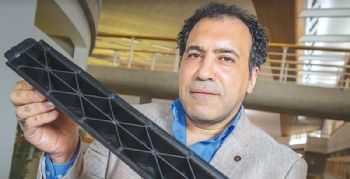
Ahmed Elmarakbi, professor of automotive composites at the University of Sunderland (
www.sunderland.ac.uk), has produced the world’s first prototype composite component to include graphene.
He is leading a European Commission project exploring how this ‘wonder material’, which is just one atom thick, could be used to create lighter, stronger and more energy-efficient vehicles.
Along with five research partners from Italy, Spain and Germany, he has been analysing the properties of graphene and
how it behaves.
For the bumper of a car, graphene was embedded in a polymer and mixed with traditional carbon fibre or glass fibre structural material, which made it lighter, stronger and tougher, allowing the researchers to reduce the thickness of the structural components.
Mr Elmarakbi said: “The material is very light and very strong, and the impact testing we did showed a 40% higher specific-energy absorption than traditional composite materials.
It is also more stable, with a controlled fracture when you hit it, even at a higher velocity.
"We expected this at the beginning, but we did not expect the results to be this high.” The ultimate prize is new lightweight components for vehicles, leading to significantly lower fuel consumption and emissions.
However, Mr Elmarakbi added that there are still challenges to be overcome. There are difficulties in applying the graphene, as the thicker it’s applied, the more brittle it becomes.
It’s also difficult to uniformly disperse the graphene in the polymer, but getting the right balance between them is crucial — to ensure that the composite component is neither too weak nor too strong.
“We have a very good uniform dispersion now, but it’s not an easy task. Part of the challenge in reaching this point has been that everything we’re doing is a first. We’ve even had to design the software to simulate the graphene applications from scratch.
“We’re in talks with the automotive manufactures and their Tier One suppliers, who are very interested in our work and how they might apply our findings in the future.”